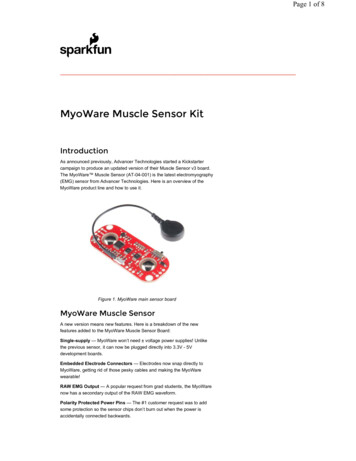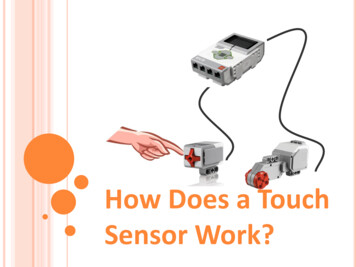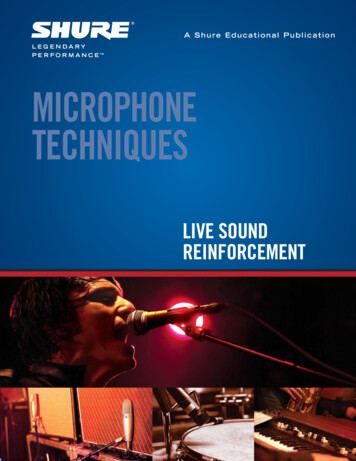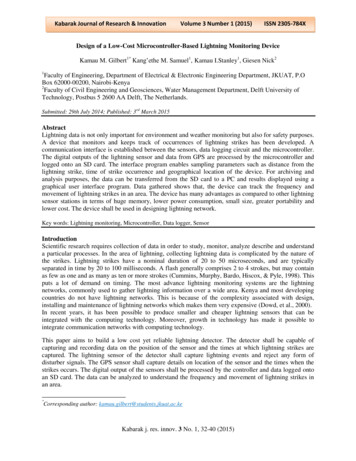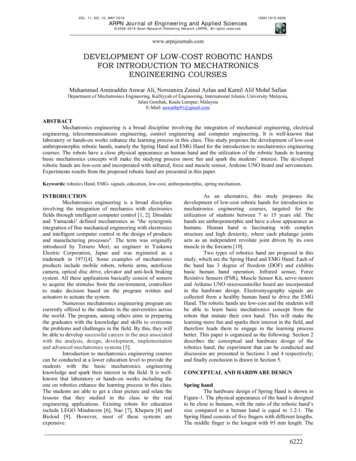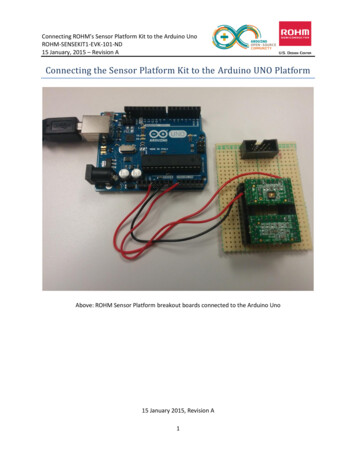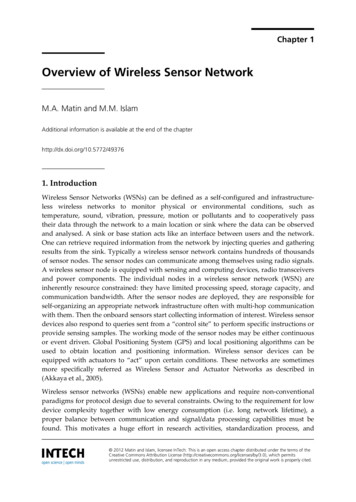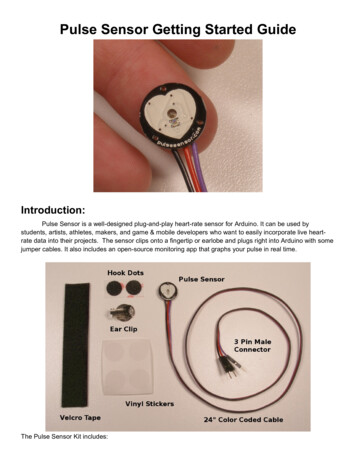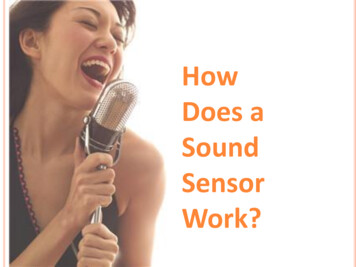
Transcription
HowDoes aSoundSensorWork?
Sound Sensor Pre-Quiz1.How do humans sense sound? What is thesound sensor in the human body?2.Provide an example “stimulus-sensorcoordinator-effector-response” frameworkusing the human ear.3.Give examples of sensors in engineeringsystems that are similar to the humansound sensor.2
Sound Sensor Pre-Quiz Answers1.2.3.How do humans sense sound? What is the soundsensor in the human body?We have two ears that enable us to hear sounds.Provide an example of “stimulus-sensor-coordinatoreffector-response” framework using the human ear.Example: sound waves from thunder human ear human brain leg muscles run for shelterGive examples of sensors in engineering systems thatare similar to human sound sensor.3Examples: LEGO sound sensor; microphones inphones, computers, karaoke machines, etc.
Human Ear Anatomy4
Human Ear and Sound SensorHow do we hear a song or any sounds? Pressure vibrations in the air are perceived as sound.Example: A speaker causes air to vibrate in the pattern(wave) shown in the diagram below, and our ears pick thisup as sound. From your outer ear, these vibrations pass through your earcanal and reach the middle ear. In the middle ear, the vibrations hit the ear drum(tymphanic membrane) and cause it to vibrate as well.5
Human Ear and Sound SensorThe ear drum vibrates three small bones in the ear in turn,the hammer, anvil and stirrup (ossicles). Then the stirrup passes these vibrations to a coiled tube inthe inner ear called the cochlea. The cochlea is filled with fluid and hair-like small nerveendings called “cilia,” which pass the information to theauditory nerve. The auditory nerve carries the signal to the brain. Watch the “How the Ear Works” video: (2:02 minutes)http://www.youtube.com/watch?v bKy02f1pD4&feature youtu.be&src vid ahCbGjasm E&feature iv&annotation id annotation 15431191256
Review: From Stimulus to Responsestimulus sensor coordinator effector responsesound ear nervous system muscle movementFrom the sequence of steps above, this iswhat happens when you hear a loud noise such as thunder:The stimulus is sound, the sensor is your ear that senses it and relays itthrough the auditory nerve to your brain, which is the coordinator.The coordinator makes the decision of how to react, and then commands theleg muscles (the effector) to run for safety.So, we go from stimulus (sound) to response (using muscles to get to safety).Do This: Sketch out the stimulus-to-response sequence for arobot sound sensor. Identify all the components, as in theexample listed above.7(Example answer on slide 18)
Review:Robot Sensors(As stated in an earlier activity,) robot sensors:Gather information from the surroundings and send it to thecomputer brick Robot sensors can only be used if the robot’s program asks forinformation from them! Similarly, the robot can only act on information from the sensors ifits program tells it to do so! How do sensors send signals to the LEGO computer (brick)? The sensors send information through wires (similar to the nervoussystem in your body) that connect them to the LEGO brick, whichuses the information if its program requires it.8
What is sound and how can you sense it? What is sound?Sound is made of sound waves or air vibrations.Louder sounds produce larger vibrations.Higher pitch sounds produce more frequent vibrations.The sound sensor has a thin piece of material called adiaphragm that vibrates when hit by sound waves (similarto how your eardrum vibrates when hearing sound).The vibration of the diaphragm is converted by the sensorinto an electrical signal that is sent to the LEGO brick, whichknows that a sound has been heard.9
What is a microphone?The LEGO sensor is similar to a microphone. A microphoneconverts sound energy to electrical energy.The microphone (on the left) has a diaphragm that moves withsound. This motion is converted to electricity using a magnetand coil (as you will learn later in physics and engineering).10
LEGO Sound Sensor a Simple Microphone A microphone can sense sound level and sound frequency. The LEGO sound sensor is similar to a microphone, in that itcan sense sound level, but it cannot detect sound frequency. The LEGO sound sensor provides a value between 0 and100% depending on the level.11
How Are Sound Sensors Made?In engineering, the term “auditory” refers tosomething related to sound, so sound sensors are alsocalled auditory sensors.The LEGO sound sensor has a diaphragm (under theyellow/orange foam ), similar to the microphoneused for a karaoke machine.The air pressure vibrations make the diaphragm move,and this diaphragm motion is sensed and converted 12into electrical signals.
Sound Level (dB) and LEGO Brick ReadingsSound sensors also tell you the sound “level.”The best known example of a sensor that can measure the sound level isthe decibel meter, but a baby alarm can also register the sound level. If ababy cries too loud it sounds the “alarm” in the parents’ baby intercom sothey hear the baby cry.We measure the sound level in decibels (dB). When you talk to a person ina normal voice, the sound level is 40 to 60 dB. When you make a lot ofnoise, the membrane of the microphone moves much more and youmeasure a level of sound that is higher than 90 dB.The LEGO sound sensor detects the decibel level. The sound sensor canmeasure sound pressure levels up to 90 dB, about the level of alawnmower. Sound sensor readings on the LEGO brick are displayed in thepercentage (%) of sound the sensor is capable of reading. The sound levelof this sensor is represented in %. 5%5-10%10-30%30-100%quiet roomtalking at a distance from the sensortalking into the sensor / playing background musicshouting into the sensor / very loud music13
Let’s ExperimentHow Does the LEGO brick/computer read the signal from the sound sensor?Do This: Attach the LEGO sound sensor to the LEGO brick as shown below. Then use the VIEW command and speak into the sensor or make different sounds.Pressing the button closes the circuit and sends a signal to the computer.Look at the display as it shows % values for different sounds.After this, check the workingof the sound sensor using the“Try Me” option. Note your observations on a separate sheetof paper and show to the teacher.14
Sound Level (dB) and LEGO Brick ReadingsThe LEGO sound sensor can be used in three different “modes.”1.This block measures the sound level and then sends it asa logical signal (true/false) via the wire. If the sound levelis above a certain limit, then the “true” signal is sent. If it isunder a certain limit it sends a “false” signal.2.Another way is the “Wait” block, which lets you makethe LEGO robot wait until the sound sensor registers therequired sound level. Once it hears a loud enough sound, therobot continues to the next task.3.Yet another way is the “Switch” block. The LEGO robotperforms one task when it does not hear the soundsignal and a different task when it does. This is atrue/false function.For example you’re now able to make the robot move forwardas long as the sound sensor doesn’t register 50% of itsmaximum sound level. When it does reach this sound level it15performs another task, such as driving around in circles untilthe sound drops below 50% again.
Sound Sensor Post-Quiz1.How do humans sense sound? What is thesound sensor in the human body?2.Provide an example “stimulus-sensorcoordinator-effector-response” frameworkusing the human ear.3.Give examples of sensors in engineeringsystems that are similar to the humansound sensor.16
Sound Sensor Post-Quiz Answers1.2.3.How do humans sense sound? What is the soundsensor in the human body?We have two ears that enable us to hear sounds.Provide an example “stimulus-sensor-coordinatoreffector-response” framework using the human ear.Example: sound waves from thunder human ear human brain leg muscles run for shelterGive examples of sensors in engineering systemsthat are similar to human sound sensor.17Examples: LEGO sound sensor; microphones inphones, computers, karaoke machines, etc.
Answer for Slide 7 Questionstimulus sensor coordinator effector responsehand clap sound sensor brick motor stop moving18
Vocabulary auditory: Related to hearing. sensor: A device that converts one type of signal to another;for instance, the speedometer in a car collects physical dataand calculates and displays the speed the car is moving. transducer: Another term for a sensor (see above). ultrasonic: A sound of a frequency that humans cannot hear,but dogs and bats can.19
Image SourcesSlide 1: photo of woman singing with microphone; source: Microsoft clipart: px?qu singing&ex 1#ai:MP900409066 mt:2 Slide 4: Hearing anatomy & mechanics diagram; source: 2006, Zina Deretsky, National Science Foundation,Wikimedia Commons: http://commons.wikimedia.org/wiki/File:Hearing mechanics.jpgSlide 5: sound waves; source: authorSlide 7: photo of lightning in the sky; source: Microsoft clipart: px?qu thunder&ex 1#ai:MP900400460 Slides 8, 11, 12, 14: LEGO device images; LEGO MINDSTORMS NXT User’s GuideSlide 10, 11: microphone; source: Microsoft clipart: px?qu microphone&ex 1#ai:MC900433836 Slide 10: Cross section of dynamic microphone; source: Total hones/microphones.htmlSlide 15: screen captures; source: author20
Sound sensors also tell you the sound “level.” The best known example of a sensor that can measure the sound level is the decibel meter, but a baby alarm can also register the sound level. If a baby cries too loud it sounds the “alarm” in the parents’ baby intercom so they hear the baby cry. We m

